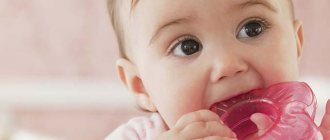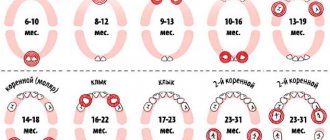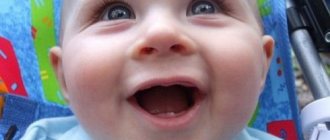From this article you will learn:
- the best remedy for teething in children,
- Will homeopathy be effective?
- When can you use Panadol or Nurofen?
To relieve symptoms during the eruption of the first teeth, not only special pain-relieving gels for gums, but also systemic drugs can be used. The latter also include a group of homeopathic medications, among which the most popular are oral medications – “Dantinorm Baby” and “Dentokind”, as well as Viburkol suppositories for rectal use.
The big advantage of such drugs is that they not only soothe the gums during teething, but also help cope with the baby’s nervousness and help restore healthy sleep. In addition to homeopathic remedies, more serious drugs can be used, such as Panadol and Nurofen (based on paracetamol and ibuprofen, respectively). They are used from 3 months, and the optimal indication for their use is the presence of a child with fever or severe pain due to teething.
What does the eruption of baby teeth look like?
Thus, depending on the severity of the symptoms, you can - 1) either use an anesthetic gel for local use in the oral cavity (they are also available only with herbal components), 2) use one of the systemic drugs, 3) or combine an anesthetic gel with the drug for oral or rectal use.
As you will see below, the latter option makes sense, because... Systemic homeopathic preparations, although they do not have a pronounced analgesic or anti-inflammatory effect, nevertheless, they can reduce nervousness and normalize the child’s sleep (due to the inclusion of herbal components with a sedative effect). In addition, one of these drugs can, among other things, reduce salivation in an infant, preventing choking on saliva and drooling from the mouth.
Teething order
Is your baby about to turn 6 months old and are you noticing some anxiety in his behavior? This is natural, because the time of teething comes. And this is a difficult period in a child’s life.
The timing of teething in children can vary widely. Normally, the first teeth begin to appear closer to 6 months.
But it happens that baby teeth erupt earlier or much later. And there is nothing terrible here; this process is associated with the constitutional characteristics of the child.
- If you follow the pattern of teething in children, the central incisors on the lower jaw appear first. This usually occurs at 6-10 months.
- The upper central incisors appear at 8-12 months, and the first molars at 13-19 months.
- The canines “wake up” last – by 16-22 months.
- By the age of 2, a child usually already has 20 teeth, and from 6 to 12 years, baby teeth are gradually replaced by permanent teeth.
- Wisdom teeth do not have a milky version and appear in late adolescence.
Tips for parents
The period of teething is stressful, first of all, for the baby himself; he can turn from a calm, sweet child for some time into an uncontrollable, capricious, always crying one. All this is temporary, and the more parents pay attention and care to him, the calmer they react to all negative manifestations of behavior, the easier it will be for everyone to get through this difficult time. It is important to try to distract the child from unpleasant sensations with some kind of entertainment: games and toys, household items, songs, cartoons, fairy tales.
At this time, it is important not to go to great lengths in the form of trying out various medications just to calm the child down. In case of doubt, it is better to consult a doctor once again, but you should not engage in amateur activities. The same applies to the opposite situation, when even if prescribed by a doctor, parents avoid medications in every possible way, explaining that everything should proceed naturally without outside interference. If the child is really unwell, you should not refuse “helpers”.
It happens that during this period children refuse to eat - it is possible that this is due to discomfort in the mouth due to contact of aching gums with food. In this case, you can try cooling the food a little. Perhaps it is worth offering your child some natural edible teethers, dryers, for example, more often. But you still can’t do without purchased ones; it is advisable to have at least 2, one of which can have a cooling effect (you just need to monitor its integrity).
Teeth from birth? It happens
In exceptional cases, children are born with teeth. As a rule, we are talking about the lower incisors. They are called (neo)natal teeth. They erupt within 30 days. Their root is mobile, not formed, and often such teeth quickly fall out.
This feature is fixed genetically - as a rule, the parents had the same thing, a characteristic picture is observed in the baby’s brothers and sisters. Doctors suggest removing such teeth to prevent them from entering the respiratory tract. But this is not a mandatory procedure, at the discretion of the parents.
Teething symptoms
The appearance of teeth causes some discomfort in children, which affects their behavior and general condition. In the support chat for the online course “For Every Mom,” we will look in more detail at the main symptoms and means of helping the child and mother. May this period pass as calmly as possible for you.
Teething has accompanying symptoms that will help you understand the cause of these changes:
- Salivation
- Irritation and rash around the mouth
- Change in stool (usually loosening)
- Runny nose
- Temperature increase
- Anxiety
- Moodiness
- Sleep disturbance
This process is not fast. Discomfort may occur several days before gum eruption. If this stage is delayed, they speak of difficult eruption.
There is no reliable information about why the temperature rises during teething in children. It can be assumed that this is a preventive protective reaction of the body. After all, as a result of teething, a tooth creates a wound in the gum, and the body proactively turns on a protective mechanism in the form of inflammation and an increase in temperature. This is necessary to prevent infection of the wound surface...
Homeopathic remedies
The choice of homeopathic remedies for teething is generally small, and in this case only a few are widely used:
- Dentinorm Baby drops are a multicomponent drug that helps relieve discomfort in a child. Manufacturers have selected the most convenient form of release - the product is in containers with a single dosage. You can use it up to 3 times a day, but, as a rule, the effect of 1 bottle is enough for the whole day. Usually kids like the taste of this product. There are no age restrictions. The effect after taking the drug occurs after about 20 minutes;
- Traumeel ointment is one of the most popular products that has an anti-inflammatory and analgesic effect;
- Viburkol candles. They are used, of course, not only for teething. The drug is a good assistant in the treatment of many infectious diseases. In the case of babies, rectal suppositories are undoubtedly the most convenient means to use. “Viburkol” is used for weakness, elevated temperature, in order to mobilize a person’s internal strength to fight the disease. This antispasmodic has a sedative, analgesic, and anti-inflammatory effect. In addition, it is considered such a safe drug that it is prescribed even to newborn babies. For children under 6 months, use 1 candle 2 times a day. For very young children, perhaps half a suppository will be enough; to do this, you need to cut the candle in half lengthwise and, after warming it up a little in your hands, smooth out the sharp corners. Older children – also 1 piece, but 4-6 times a day;
- Dentinox is a gel that also helps with teething due to its analgesic properties. Apply to inflamed gums using rubbing movements;
- "Dentokind" is a homeopathic medicine in the form of lozenges. The product contains active ingredients that eliminate pain when teething. This home remedy reduces swelling of the gums, lowers the temperature, and also helps prevent constipation and diarrhea. Older children will be able to hold the tablet in their mouth until it disappears completely, but infants will need to dissolve it in water. For individual dosage, please contact your pediatrician. In general, the drug is taken as follows: children under 1 year old - 1 tablet (but no more than 6 tablets per day), older children - 2 tablets (but no more than 12 tablets per day). The break between doses of the medicine should be at least 1 hour. The effect of this drug should not be expected immediately - it is a cumulative remedy, when quantity turns into quality;
- "Hamomilla 6". This remedy belongs to classical homeopathy, it is intended to calm the child during teething. The drug helps stop attacks of irritability and tearfulness, and prevent hysterics. Also, “Hamomilla 6” can improve sleep and appetite, reduce salivation and normalize stool;
- “Arsenicum album” is prescribed if the child is so exhausted during this period that he has even lost weight, he has weakness, thirst and watery diarrhea;
- "Causticum" - for diaper rash during teething;
- "Mercurium Solubilis" eliminates pathological reactions during teething: excessive salivation, runny nose, cough, watery greenish stool with an unpleasant odor;
- "Hemlock" eliminates convulsions during teething;
- "Coffea" fights insomnia, nervous irritability;
- “Colocyntis” is attributed to inflammation of the gums and difficult teething, combined with abdominal cramps and moodiness;
- "Cuprum aceticum" is effective for convulsions - the case when a child does not manage to come to his senses for a long time, he literally buries himself in the pillow. This condition is accompanied by a constant change of blush and pallor;
- “Ignation” is needed for twitching throughout the body during teething;
- “Magnesia muriatica” is necessary when children cannot digest milk during teething. This is also accompanied by constipation with scanty pea-sized stools;
- “Magnesia phosphorica” is prescribed if children complain of pain during teething and feel better with warmth;
- “Belladonna” will relieve high fever well, calm the child, relieving nervous excitement with spasms, convulsions, and pronounced pain;
- Nux vomica is prescribed for constipation. Take alternately with the drug "Sulfur" or only one of them;
- “Reum” - for difficult teething, accompanied by sour diarrhea;
- “Etuza” is used for malaise and poor health during teething. Symptoms occur suddenly and are severe. These include milk rejection: this product causes vomiting of coagulated clots;
- Borax is used if teething is accompanied by stomatitis and diarrhea. This remedy helps to soften bleeding and inflammation of the gums, soothe, normalize sleep and appetite;
- “Baby Doctor” is a tasteless and odorless gum gel, which makes the product easier to use for small children. It helps eliminate all discomfort associated with teething. "Baby Doctor" is recommended for children over 3 months. It can also be used at a later age - when permanent teeth erupt.
Despite the safety of these products, it is better to consult a doctor before using (especially the first time). Next time, if the symptoms are the same, you can use the prescribed remedy yourself.
How to make teething easier
- First of all, it is necessary to remain calm and reassure the child that everything is under control and soon his suffering will end.
- Teething is accompanied by itching in the gums, which forces the child to chew on any hard objects. Provide him with clean and safe teethers - special rings, toys, rags.
- Cold significantly relieves pain and itching in the inflamed gums. You can pre-cool the teether in the freezer, apply ice wrapped in a cloth or bandage for a short time.
In medicine, during teething, special gels are actively used, which are applied to the gums at the site of inflammation: “Cholisal”, “Dentinox”, “Kalgel”... All of them have a local anesthetic effect. And any anesthesia has a detrimental effect on the body, suppressing its defenses.
However, you can ease your child’s suffering while strengthening his immunity. Homeopathy will help you with this. This method is very effective and safe for the baby.
Signs and help with teething
How to understand that your baby is unwell due to teething? The main signs are severe salivation, swelling of the gums, in which the child constantly tries to put his hand in his mouth. The temperature often rises, a runny nose and diarrhea appear, and the baby becomes lethargic. However, even if you have a fever for several days, doctors do not recommend bringing it down; this can only be done in case of severe fever. By the way, a runny nose is not a consequence of a viral infection. This phenomenon will go away immediately after the tooth “hatches”, so there is no need to fight it. But you can help a child “scratch” his teeth; for this now there are many different devices made of silicone - it is better if they have no liquid inside, there is a possibility of it leaking out when biting. You can get by with natural remedies - dried bread, crusts of bread, hard cookies, some even freeze cucumbers, bananas, carrots.
You can often find a baby chewing things, diapers, towels - such self-help also has a place. You can also try massaging your gums by wrapping a bandage around your finger. If such measures are not enough, then you can resort to the help of special gels; they have a local anesthetic effect: “Kalgel”, “Cholisal”, “Kamistad gel”, “Dentinox gel”, “Fenistil”. All of the listed medicines are classified as traditional medicine, but there are also homeopathic medicines based on natural raw materials.
Chamomilla
- A child in the Hamomilla state is capricious and irritable. He kicks, bites, fights, asks to be carried.
- He may demand one toy or another, but having received what he wants, he instantly loses interest in it and throws it away. Malaise is accompanied by outbursts of anger.
- The condition worsens at night, better from motion sickness (in the car, in a stroller). Strong-smelling, green, lumpy stools. A characteristic detail is that one cheek may be red and the other pale. The head sweats profusely, the sweat is hot.
Calcarea carbonica
- Children of this type are well-fed, chubby, but have flabby muscles. During sleep, the Calcarea child's head sweats, especially the back of the head. Sweat has a sour smell.
- These are children with late teething; the teething process itself is long. Such disorders are associated with calcium deficiency, which is poorly absorbed in this constitution.
- Tendency to frequent colds and ear infections. A passionate desire for eggs (especially soft-boiled ones), cheese and milk, as well as sweets is a sure sign of a calcareous child.
- He is worse in cold damp weather, better in warmth.
Homeopathy for babies
Medicines for Infants Dosage: Take 4 -5 granules three or four times a day or, if the pain is very severe, at intervals of half an hour to an hour. If the patient's condition improves, reduce the frequency of dosing: stop taking the medicine when a reliable improvement in the condition is achieved.
| Medicine | Specific indications | Main symptoms | Worse | Better |
| Aconitum narellus Cold | The initial stages of a cold A cold quickly localizes in the chest Sharp sounds when breathing | Sudden onset of symptoms Illness begins after exposure to cold, dry wind | At night In a warm room From lying on the sore side | Outdoors |
| Croup | Hoarse, dry cough Loud, labored breathing Holding the throat when coughing | Motor restlessness! Anxiety, fear | ||
| Diarrhea | Watery stools. Child cries: insomnia. exhibits motor restlessness | |||
| Ear infections | Outer ear swollen, hot, red, painful | |||
| Vomit | From nervous shock or fear Profuse sweating Frequent urination | |||
| Arsenicum album Diarrhea | From spoiled food From excessive consumption of fruit Frequent, dark-colored stools with a foul odor After eating and drinking | Anxiety Weakness Thirst quenched by small sips of water Burning pain | On the right side of the body After midnight From eating and drinking From cold On the sea coast | From the heat From warm drinks |
| Vomit | From spoiled food From excess fruit in the diet After eating and drinking Nausea | |||
| Belladonna atmountain Cold | Sudden strong onset Restlessness Red face, hot and dry skin Feverish state | In the afternoon | In a half-bent position | |
| Ear infection | For a cold head or a wet head Usually the right ear | Red eyes, increased sensitivity to light: pupils are dilated Pulse is firm, strong and rapid | In a lying position From touch From shocks and shaking From noise | |
| Teething | Irritable Delusional state; may bite or hit | |||
| Angina | Throat bright red | |||
| Vomit | From fear From nervousness | |||
| Bryonia alba Cold | Dry and stuffy nose Dry lips Harsh dry cough | Wants to be left alone Irritability; demands something with screams and tears, then refuses what is demanded | ||
| Colic | Worse from motion and heat | Thirst with desire to drink in large quantities | From any movement or movement From touch From heat | In peace In silence |
| Vomit | From fatty foods From high-calorie foods | Constipation with hard to dry stools | ||
| Сalcarea carbonica Colic Teething | Milk intolerance Late teething Poor absorption of calcium by the body | Milk intolerance “Light” complexion, plump Sweating of the head; fontanelles heal late | From any cold or chill From physical or mental stress From wet weather | From lying on your sore side From dry weather |
| Calcarea phosphorica Teething | Late teething | Dark hair and eyes, thin build; fontanelles close late | From damp, cold weather From melting snow | In summer In warm dry weather |
| Calendula officinalis (lotion)For minor cuts and scrapes | Relieves pain Accelerates healing | |||
| For diaper dermatitis | Reduces pain Accelerates healing | |||
| Chamomilla vulgaris Colic | Pulls the legs up towards the stomach. Bloating. | Wants to be carried in arms all the time; one cheek is red, the other is pale. | At night From the heat In the fresh air | When held by adults |
| Diarrhea | Greenish, sticky, mucous stool during teething | Irritability, asks for something, and when he receives it, throws it away | Out of anger | From warm wet weather |
| Ear infections | Very severe pain; the child is beside himself in pain | Insomnia in the presence of drowsiness | ||
| Teething | Irritability Insomnia despite extreme fatigue Diarrhea with greenish stools | |||
| Colocynthis Colic | He doubles over in pain, pulls his legs towards his stomach, presses on his stomach | Abdominal bloating Irritability | From anger From eating or drinking even in minimal quantities | In a double-bent position From heat From firm pressure |
| Diarrhea | Stool resembles jelly Severe cramps A piece of food causes an attack of diarrhea | |||
| Dulcamara Diarrhea | Severe cramps Diarrhea occurs immediately after eating Stools are watery, sticky, with blood, mucus, green in color | Diarrhea occurs after exposure to cold, damp weather Increased sensitivity to cold | At night In cold, damp weather | From external heat From constant movement |
| Ear infection | Stitching pain Buzzing in the ears | |||
| Ferrum phosphoricum Ear infection | Initial stages, before abscesses appear in the ears Throbbing pain | The disease occurs gradually High fever Pale face with red cheeks Anxiety Insomnia | On the right side From touch From movement From shock and shaking | From cold compresses |
| Gelsemium sempervirens Colds, flu | Apathy, detachment, indifference Eyes barely open, heaviness in the eyelids High temperature Chills running up and down the back Soft, vague pulse Lack of thirst Symptoms develop several days after exposure to the factors that caused the disease | At 10 a.m. In wet weather From excitement | In the fresh air From prolonged movement After excessive urination | |
| Hepar sulphuris Cold | Constant discharge Yellow discharge from one nostril Rough breathing Wet, gurgling cough | Sensitivity to drafts Irritability Sweating | In dry cold weather | And damp weather From the heat After eating |
| Ear infection | Stitching pain radiating from throat to ears | |||
| Angina | Stitching pain radiating from throat to ears | |||
| Ipecacuanha Vomiting | After eating Uncontrollable vomiting | Tongue without plaque, clean Constant nausea | From the moist warm wind In a lying position | |
| Magnesia phosphorica Ear pain | Severe neuralgic pain | On the right side of the body From cold At night | From the ashes From the pressure | |
| Mercurius solubilis Cold | Accompanied by diarrhea | More intense salivation than usual Sweating Unpleasant odor Weakness, trembling | At night In humid weather From sweating From lying on the right side In a warm room From the warmth of the bed | |
| Diarrhea | The stool is sticky, with blood, with mucus, greenish in color. A feeling of incomplete bowel movement. | |||
| Angina | Swelling of the cervical glands | |||
| Nux vomica Cold | Nose runs during the day Nasal congestion at night and in the open air | Irritable Belching | At 4 am after eating From touch | In the evening After continuous daytime sleep From firm pressure From humid weather |
| Constipation | Pushing with little result | |||
| Diarrhea | Appears as a result of overeating Strong attempts to defecate with no or little result | |||
| Phosphorus Vomiting | Thirst with desire for cold water, vomiting immediately; as soon as it warms up in the stomach | In the evening From touching From drinking From warm food | From the cold In the fresh air From cold food From sleep | |
| Podophillum peltatum Diarrhea | Occurs after bathing, eating or drinking Uncontrollable urge to defecate Diarrhea contains undigested food Watery | Early morning hot weather Teething | ||
| Pulsatilla nigricans Cold | Used for “mature” colds Thick, creamy discharge that does not irritate the skin of the face | Wants to be outdoors Craves attention Changeable mood Tearful | From the heat After eating | Outdoors From movement From cold applications |
| Constipation | Painful, swollen belly | There is no thirst | ||
| Diarrhea | From overeating Pushing with little or no results | |||
| Ear infection | The outer ear is swollen and red Thick, yellow discharge that does not irritate the skin: foul odor Pain worsened by warmth | |||
| Silicea terra Teething | Painful P0later | Irritability cannot tolerate interference in his affairs Sweaty feet, hands, head and neck Milk intolerance Thin delicate skin Thin sandy hair Lively and quick-witted | In the morning In a position lying on the left side In a lying position From washing From cold | From the warmth From wrapping your head in a blanket |
| Verbascum thapsus Ear infections | Usually in the left ear Decreased hearing | Left-handed remedy | From 9 am to 4 pm From the effort of bathing From temperature changes From talking From sneezing |
Share your interest!
Calcarea phosphorica
- A child in the state of Calcarea phosphorica is fussy, runs somewhere all the time, complains of boredom, whines. He wants to be entertained.
- The teeth of such children appear slowly and late, immediately grow bad and weak, and quickly decay.
- People of this type do not like drafts, they feel worse in the spring, better in dry, warm weather, lying down.
These are the main homeopathic remedies that are suitable for difficult and painful teething in babies. To learn to see the symptoms, understand the processes occurring during illness, be able to select remedies, create your own family homeopathic first aid kit and use it on occasion, we invite everyone to the video course on children’s health “For Every Mother”.
Go to video course









